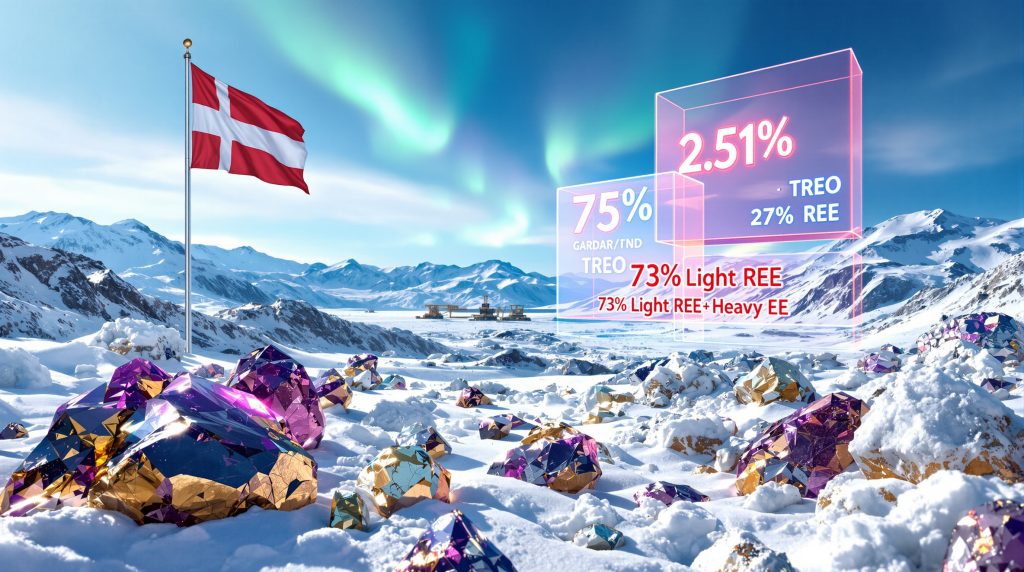Understanding the Ilua Pegmatite Zone's High-Grade REE Potential
Amaroq confirms high-grade REE at Nunarsuit represents a significant milestone for rare earth element exploration in South Greenland. The discovery at the Ilua pegmatite zone marks the company's first verified REE occurrence within the 16 km by 27 km Nunarsuit intrusive complex, with rock-chip sampling revealing exceptional grades reaching 2.31% total rare earth oxide (TREO).
The mineralization characteristics present several encouraging factors for potential development. Laboratory analysis indicates the REE composition consists of approximately 73% light rare earth elements and 27% heavy rare earth elements, providing a balanced distribution across the REE spectrum. Particularly noteworthy is the 21% concentration of magnet-critical elements including neodymium, praseodymium, dysprosium, and terbium, which are essential for permanent magnet manufacturing in electric vehicles and renewable energy applications.
Field mapping has identified a 5-kilometer mineralized trend consisting of pegmatite veins several meters wide, with multiple sub-parallel structures suggesting potential for resource expansion. The uranium content remains below Greenland's regulatory thresholds, potentially simplifying future permitting processes compared to other regional REE deposits.
Key Discovery Metrics:
- Maximum TREO grade: 2.31%
- Average REE distribution: 73% LREE / 27% HREE
- Magnet metal content: ~21% (Nd, Pr, Dy, Tb)
- Identified trend length: ~5 kilometers
- Vein width: Several meters
- Uranium levels: Below regulatory limits
Why Monazite-Hosted Mineralization Offers Processing Advantages
The geological interpretation suggests monazite serves as the primary host mineral for REE mineralization at Ilua, presenting significant processing advantages over alternative mineral systems prevalent in Greenland. Monazite mineralization typically responds favorably to conventional acid leaching extraction methods, contrasting sharply with the complex metallurgical challenges posed by eudialyte and steenstrupine systems found elsewhere in the region.
Processing Benefits of Monazite-Hosted Systems:
- Standard acid leaching techniques applicable
- Reduced radioactive waste generation
- Established industrial processing protocols
- Lower chemical complexity requirements
- Conventional reagent usage patterns
The distinction becomes particularly relevant when comparing Amaroq's discovery with other Greenlandic REE projects. Eudialyte-hosted deposits typically require specialized processing technologies and generate substantial radioactive waste streams, increasing both capital expenditure and operational complexity. Furthermore, mining waste management solutions become critical considerations when evaluating different deposit types. Steenstrupine systems present even greater metallurgical challenges, often requiring novel extraction methods with uncertain commercial viability.
| Deposit Type | Processing Method | Radioactive Handling | Infrastructure Needs | Cost Profile |
|---|---|---|---|---|
| Monazite-hosted | Conventional acid leach | Minimal requirements | Standard facilities | Lower CAPEX/OPEX |
| Eudialyte systems | Specialized extraction | Extensive protocols | Enhanced facilities | Higher costs |
| Steenstrupine | Novel technologies | Complex handling | Specialized infrastructure | Premium costs |
The monazite advantage extends beyond processing simplicity to include established supply chains for reagents and equipment, reducing project development risks and timeline uncertainties that typically plague novel metallurgical approaches.
How Does the Gardar Belt Context Enhance Investment Appeal?
The Nunarsuit license sits strategically within the globally recognized Gardar igneous province, a geological setting that hosts several world-class REE projects including the Kvanefjeld and Tanbreez deposits. This regional context provides multiple layers of validation for Amaroq's discovery and suggests potential for district-scale development opportunities. Additionally, rare earth reserves analysis demonstrates how geographical concentration affects global supply dynamics.
The Gardar belt represents one of the most significant alkaline igneous provinces globally, formed approximately 1.3 billion years ago through extensive magmatic activity. This geological process concentrated REE mineralization across multiple intrusive complexes, creating a regional endowment that has attracted international mining companies and strategic investors.
Regional Strategic Advantages:
- Proven geological model for REE concentration
- Established mining industry presence
- Potential infrastructure sharing opportunities
- Regional geological expertise availability
- District-scale exploration synergies
The 16 km by 27 km Nunarsuit intrusive complex remains largely unexplored for REE potential beyond the initial 5 km trend identified at Ilua. This suggests substantial upside for resource expansion through systematic exploration, potentially unlocking multiple mineralized zones within the broader intrusive system.
Proximity to existing REE projects may also facilitate infrastructure sharing arrangements, reducing individual project development costs and accelerating potential production timelines. The regional concentration of REE deposits creates opportunities for collaborative development approaches and shared processing facilities.
What Critical Questions Must Be Addressed Through 2026 Drilling?
While surface sampling results demonstrate encouraging REE grades and favorable mineralogy, several fundamental uncertainties require resolution through the planned spring 2026 scout drilling program. The transition from surface outcrop data to drill-confirmed mineralization represents a critical validation step for investment evaluation. Consequently, proper drill results interpretation guidance becomes essential for evaluating exploration outcomes.
Primary Technical Validation Requirements:
- Depth continuity of high-grade mineralization zones
- Confirmation of monazite as dominant host mineral
- True width and structural geometry of pegmatite systems
- Grade consistency across identified trend length
- Structural controls on mineralization distribution
The depth continuity question represents perhaps the most critical uncertainty facing investors. Surface sampling, while encouraging, provides limited insight into mineralization behavior at depth. Pegmatite systems can exhibit significant grade variability and structural complexity that surface expressions may not accurately represent.
Economic Feasibility Dependencies
- Recoverable resource tonnage estimates
- Metallurgical recovery rates under standard processing conditions
- Reagent consumption patterns and energy intensity requirements
- Infrastructure development costs and timeline
- Environmental permitting pathway clarity
Metallurgical testing programs will need to validate assumed processing advantages of monazite-hosted mineralization. While conventional wisdom suggests simpler processing routes, actual recovery rates and reagent consumption must be confirmed through representative sample testing.
How Does Amaroq's Financial Position Support REE Development?
Amaroq's diversified operational foundation provides crucial financial flexibility for systematic REE exploration advancement. The company's primary gold operations at Nalunaq generate operational cash flow, reducing dependence on equity financing for exploration activities and minimizing shareholder dilution during the discovery validation phase. Moreover, junior mining investment strategies emphasise the importance of cash-generating assets in funding exploration activities.
Based on Q2 2025 financial disclosures, Amaroq maintains strong financial metrics with a C$86 million cash position, providing substantial runway for exploration activities without immediate financing pressures. The company's improving plant throughput targets at Nalunaq suggest strengthening operational cash generation capabilities.
Financial Strength Indicators:
- Cash reserves: C$86 million (Q2 2025)
- Primary revenue source: Gold production at Nalunaq
- Improving operational metrics and throughput targets
- Dedicated 2025 exploration budget including REE programs
- Multi-exchange listing providing financing optionality
The financial diversification strategy allows Amaroq to pursue REE development without over-reliance on speculative equity raises, a common challenge facing single-project exploration companies. This stability enables methodical exploration approaches and reduces pressure for premature development decisions.
The company's listing across multiple exchanges (AIM, TSX-V, Nasdaq Iceland, OTCQX) provides access to diverse investor bases and financing options should additional capital requirements emerge during advanced exploration phases.
What Makes the Magnet REE Content Strategically Important?
The approximately 21% magnet-critical element content positions Amaroq's discovery favorably within evolving global supply chain security considerations. The concentration of neodymium, praseodymium, dysprosium, and terbium addresses specific supply vulnerabilities in permanent magnet manufacturing sectors. In addition, critical minerals energy transition requirements continue driving demand for these strategic elements.
Global magnet metal supply chains remain heavily concentrated in China, creating strategic vulnerabilities for Western manufacturing industries. The International Energy Agency projects dramatic increases in magnet metal demand driven by electric vehicle adoption and renewable energy infrastructure expansion.
Strategic Supply Chain Significance:
- Essential for electric vehicle motor manufacturing
- Critical for wind turbine generator systems
- Required for industrial automation applications
- Limited Western hemisphere production sources
- Growing demand from clean energy transition
The North Atlantic location provides geopolitical stability compared to many global REE sources, aligning with Western supply chain diversification initiatives. The United States, European Union, and allied nations have identified REE supply security as critical national infrastructure priorities.
Magnet Metal Market Dynamics
| Element | Primary Applications | Supply Concentration | Demand Growth |
|---|---|---|---|
| Neodymium | Permanent magnets, EVs | China-dominated | High growth |
| Praseodymium | High-strength magnets | Limited sources | Accelerating |
| Dysprosium | High-temperature magnets | Extremely concentrated | Critical needs |
| Terbium | Specialized applications | Very limited supply | Niche growth |
The combination of favorable magnet metal ratios and strategic location could position Amaroq's discovery as a valuable supply chain diversification asset, potentially attracting strategic partnerships or offtake agreements during advanced development phases.
When Will Investors See Meaningful Development Milestones?
The development timeline for Amaroq's REE discovery follows a structured progression through exploration, resource definition, and potential feasibility studies. The spring 2026 scout drilling program represents the next critical milestone for investment validation.
2026 Exploration Program Components:
- Scout drilling campaign targeting high-grade surface areas
- Expanded geological mapping across the 5 km trend
- Additional surface sampling to define mineralization extent
- Initial metallurgical testing of drill core samples
- Structural interpretation and resource modeling initiation
The drilling program timeline depends on Greenland's seasonal accessibility constraints and permitting approvals. Spring drilling campaigns typically commence in May-June when weather conditions permit safe helicopter access to remote exploration sites.
Key Development Dependencies
- Drill core confirmation of surface sampling grades
- Metallurgical recovery validation through representative testing
- Resource estimation development and NI 43-101 compliance
- Environmental baseline studies and community engagement
- Permitting pathway clarification under Greenlandic regulations
Successful drill results could accelerate development timelines through resource definition studies and preliminary economic assessments. However, progression to feasibility studies typically requires substantial resource delineation and comprehensive metallurgical testing programs.
How Should Investors Evaluate Early-Stage REE Risk-Reward?
Investment evaluation requires careful consideration of discovery potential against inherent early-stage exploration risks. Amaroq's REE opportunity presents both encouraging fundamentals and significant binary uncertainties typical of mineral exploration ventures.
Positive Investment Factors:
- Exceptional surface grades up to 2.31% TREO
- Favorable monazite-hosted mineralization characteristics
- Strategic location within proven REE geological province
- Strong financial backing from diversified operations
- Growing global demand for secure REE supply sources
- Management experience in Greenlandic mining operations
The surface sampling results rank among the higher-grade REE discoveries in recent exploration cycles, providing genuine discovery validation rather than marginal mineralization typical of many junior exploration projects.
Significant Risk Considerations
- No drill-confirmed resource estimates available
- Unproven metallurgical recoveries and processing costs
- Regulatory uncertainty in Greenland's evolving policy framework
- Extended development timelines typical of major mining projects
- Market volatility affecting exploration company valuations
- Infrastructure development requirements and costs
The binary nature of exploration-stage investments requires careful position sizing relative to individual risk tolerance and portfolio diversification objectives. Success depends on successful transition from surface sampling to drill-confirmed resources with proven economic viability.
What Role Does Greenland's Regulatory Environment Play?
Greenland's evolving regulatory framework for critical minerals development presents both opportunities and challenges for REE project advancement. The autonomous territory has implemented strategic minerals policies aimed at attracting responsible mining investment while protecting environmental and cultural heritage.
Recent policy developments have emphasized sustainable mining practices and strategic partnership opportunities with Western nations seeking supply chain diversification. However, regulatory processes remain complex and require extensive environmental and social impact assessments.
Regulatory Considerations for REE Development:
- Environmental impact assessment requirements
- Indigenous community consultation protocols
- Strategic minerals development incentives
- International trade relationship implications
- Sustainable mining practice standards
The relatively low uranium content at Ilua may significantly simplify permitting compared to other Greenlandic REE deposits that face extensive radioactive material handling requirements. This could accelerate development timelines and reduce regulatory compliance costs.
Greenland's government has expressed interest in critical minerals development that supports Western supply chain security objectives, potentially creating favorable policy environments for strategically important projects like REE development.
Market Psychology and Investment Timing Considerations
The rare earth elements sector exhibits significant cyclical volatility driven by supply-demand imbalances, geopolitical developments, and technology adoption cycles. Understanding market psychology becomes crucial for investment timing and position management strategies.
Current market dynamics reflect growing awareness of supply chain vulnerabilities following recent geopolitical tensions and clean energy transition acceleration. This environment has created increased investor interest in Western hemisphere REE development opportunities.
Market Psychology Factors:
- Heightened supply chain security awareness
- Clean energy transition driving demand growth
- Geopolitical risk premium for non-Chinese sources
- Limited Western development pipeline creating scarcity value
- Technology sector demand providing fundamental support
However, REE markets have historically experienced significant boom-bust cycles, with speculative periods followed by extended consolidation phases. Investors should consider long-term development timelines rather than short-term price movements when evaluating early-stage exploration opportunities.
The technical nature of REE investments requires understanding of both geological fundamentals and end-market demand drivers. Electric vehicle adoption rates, renewable energy deployment, and industrial automation trends all influence long-term demand projections.
Geological Complexity and Exploration Upside
The Ilua pegmatite system exhibits geological characteristics suggesting potential for significant resource expansion beyond the initial 5 km trend identified through surface sampling. Pegmatite-hosted REE systems often occur in swarms or clusters, indicating possible additional mineralized zones within the broader Nunarsuit intrusive complex.
Geological mapping reveals multiple sub-parallel pegmatite veins, suggesting a robust mineralizing system with potential for multiple ore zones. The structural controls on mineralization remain incompletely understood, presenting both exploration opportunities and geological uncertainties.
Geological Exploration Factors:
- Multiple sub-parallel pegmatite structures identified
- 16 km x 27 km intrusive complex largely unexplored for REE
- Regional magnetic and gravity anomalies requiring investigation
- Structural controls on mineralization distribution unclear
- Potential for district-scale resource development
Advanced geological interpretation may reveal additional target areas for systematic exploration, potentially expanding the resource base significantly beyond initial discoveries. The scale of the Nunarsuit intrusive complex suggests substantial exploration potential remains untested.
Financial Analysis and Valuation Framework
Valuation of early-stage REE discoveries requires specialized analytical frameworks that account for geological risk, metallurgical uncertainty, and development timeline considerations. Traditional discounted cash flow models prove inadequate given the high uncertainty and long development horizons typical of mineral exploration projects.
Risk-adjusted net present value calculations must incorporate multiple scenario analyses reflecting various outcomes from the 2026 drilling program. Probability-weighted valuations provide more realistic assessment frameworks than deterministic financial models.
Valuation Considerations:
- Discovery probability adjustments for drill confirmation
- Metallurgical recovery rate sensitivity analysis
- Development cost escalation factors
- REE price volatility and long-term forecasts
- Permitting timeline and success probability assessments
- Discount rate adjustments for exploration-stage risks
Comparable transaction analysis from recent REE project acquisitions and joint ventures provides market-based valuation benchmarks. However, the unique characteristics of each deposit limit direct comparability, requiring careful adjustment for geological, processing, and jurisdictional differences.
Conclusion – Evaluating Amaroq's REE Discovery Investment Merit
Amaroq confirms high-grade REE at Nunarsuit represents a credible step toward diversifying beyond gold operations into the strategically important critical minerals sector. The combination of exceptional surface grades, favorable monazite-hosted mineralization, and strategic location within the proven Gardar belt provides encouraging fundamentals for future development consideration.
The discovery's technical merits include processing advantages over complex Greenlandic REE systems, significant magnet metal content addressing supply chain security concerns, and substantial exploration upside within the largely untested Nunarsuit intrusive complex. Strong financial backing from diversified gold operations reduces financing risks typical of single-project exploration companies.
However, investment merit ultimately depends on successful validation through the planned 2026 drilling program. The transition from surface outcrop sampling to drill-confirmed resources with proven metallurgical recoveries represents the critical milestone for advancing from speculative discovery to potential economic development.
Key Investment Decision Factors:
- Drill confirmation of surface sampling grades and continuity
- Metallurgical testing validation of processing assumptions
- Resource tonnage estimates and grade consistency
- Regulatory pathway clarity and permitting timeline
- Market conditions for REE project financing and development
For investors, this discovery offers exposure to early-stage REE development within a financially stable company operating in a strategic jurisdiction. However, position sizing should reflect the binary nature of exploration-stage investments, with success contingent on systematic validation of geological, metallurgical, and economic assumptions through comprehensive drilling and testing programs.
The 2026 exploration campaign will provide crucial data for advancing investment evaluation from speculative discovery to resource-based assessment. Furthermore, mining industry analysts continue tracking developments across Greenland's mineral sector. Until drilling validates surface results and confirms processing assumptions, the opportunity remains primarily optionality-based rather than fundamentally-driven investment consideration.
This analysis is based on publicly available information and company disclosures. Mineral exploration investments carry substantial risks including total loss of capital. Investors should conduct independent due diligence and consider professional financial advice before making investment decisions.
Ready to Invest in the Next Major Mineral Discovery?
Discovery Alert instantly alerts investors to significant ASX mineral discoveries using its proprietary Discovery IQ model, turning complex mineral data into actionable insights. Understand why major mineral discoveries can lead to significant market returns by exploring Discovery Alert's dedicated discoveries page, showcasing historic examples of exceptional outcomes, and begin your 30-day free trial today to position yourself ahead of the market.




